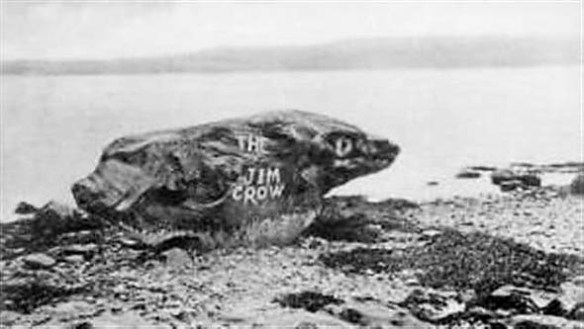So- another twist in the local debate about a painted rock on the Dunoon shoreline.
Photo c.1900
The rock has now been defaced twice by someone who decided that direct action was required to highlight the murky history that may be behind this local land mark. Local politicians have expressed their outrage-
Councillor Bruce Marshall, chair of the Bute and Cowal Area Committee, told the Standard on Tuesday: “I was unaware that Jim Crow had again been defaced and find it hard to believe that anyone can be so petty.
“Jim Crow has been a landmark on the foreshore at Hunter’s Quay all of my life and I would not like to see it permanently lost.”From Dunoon Observer.
Two people were seen yesterday redecorating the rock with its golliwog face.
The local paper has dealt with the issue in a rather lazy and partisan fashion. It reads like the reporter was looking for a way to dismiss any concerns about the rock, and seeking to interpret history in this light. A quote from the article–
In an age where international news was not widely spread, it is unlikely that Dunoon people knew about these laws when the rock was originally painted, possibly around 1900.
It seems more likely that the rock was originally named after a Thomas Ingoldsby rhyming story The Jackdaw of Rheims. which was popular in Victorian times, The poem, about a particularly pious jackdaw made ito a saint, ends with the stanza:
And on newly-made Saints and Popes, as you know,
It’s the custom, at Rome, new names to bestow,
So they canonized him by the name of Jim Crow!
The research the local reporter has done seems to ignore the pervasive influence of ‘coon songs‘ and ‘black face songs’ in the Victorian and Edwardian music halls (right through to the dreadful black and white minstrel shows that were on TV in the 1970’s.)
People in Dunoon, and holiday makers from the big city who flocked here around the turn of the 20th Century, probably did not know much about the Jim Crow laws, but they would have known that ‘Jim Crow’ was a derogatory caricature of a black man.
As for the Jackdaw of Rheims– written by Rev Richard H Barham (under the pen name Thomas Ingoldsby,) it makes one reference to Jim Crow- as part of a long poem about a Jackdaw. Here is the question- why did Barham use this name? The song ‘Jump Jim Crow‘ was a huge international hit, with sheet music sold over all the world- carrying the caricature everywhere it went. The song was written about 5-10 years before the Jackdaw of Rheims was published.
The Observer reporter appears to assume that before the internet, before radio and TV, communication of ideas like this between continents was unlikely- that there could be no real exchange of ideas between sleepy Dunoon and America. This is to totally misunderstand our history-
- The communication revolution of the modern age- the printing press.
- The connections between the Clyde basin, as a major trading port, and the Americas.
- The huge popularity of the music halls, and the spread of ‘minstrel’ songs.
- Our role in the triangular trade routes.
- In 1817 Scots owned almost a third of all the slaves in Jamaica.
- The influence of this trade on the wealth and development of Scotland.
Looking back from a totally different culture and time, there is no blame that can be attached to whoever first crudely decorated this rock and wrote ‘Jim Crow’ on its side. It was probably a bit of holiday fun. Using terms and prejudices that were so pervasive that they were hardly noticed.
The issue remains how we come to understand the symbolism contained within this image now– how we engage honestly with our past.
And this rock gives us an opportunity to do just that.
I notice that the local paper did not quote this-
“… there can be no doubt that the painting of the ‘face’, with its exaggerated red mouth, is a typically caricatured image of a black person, as popularised by the American entertainer T.D. Rice in the nineteenth century. […] I feel certain that black visitorsfrom outside would see this as somewhat insulting […] as a derogatory reference to their skin colour and origins.”
So – are we sure that this is just a little bit of harmless local colour? And even if it is just that- are we really comfortable with the associations that are being made, and the offence that this might carry to the descendants of slaves who had to fight on for generations against the oppression of the Jim Crow laws?
If the rock is to stay, then we need to tell these stories.
If we are to keep the face on the rock- then let us also put a big sign on the foreshore dealing with the darker side of our past…

